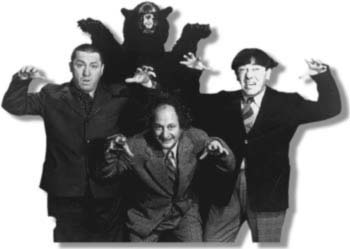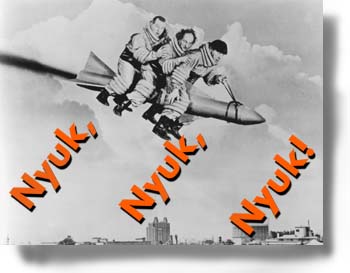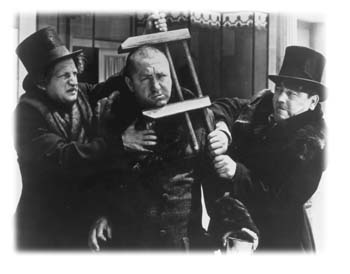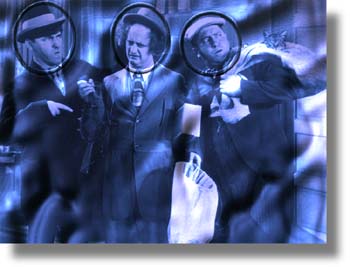![[Metroactive Movies]](/movies/gifs/movies468.gif)
![[Metroactive Movies]](/movies/gifs/movies468.gif)
[ Movies Index
| Metro | Metroactive Central | Archives
]
Nyuk, Nyuk, Nyuk!
The Moe, Larry and Curly school of a timeless social disorder
FOR A LONG TIME, I saved a letter to the editor of the LA
Reader from a man who claimed that the Three Stooges had saved his life. It
was a hot, smoggy night in Los Angeles, and the man had walked to a
convenience store. He was deciding on the right kind of beer when a gunman
came in to rob the place. The letter-writer stood stock still, hoping not to
be noticed. But then, the robber whirled around to make sure the rest of the
store was empty.
With the barrel of a gun looking at him, all the unarmed man could think to
do was to imitate Larry's own reaction in a similar moment in some ancient
Three Stooges short. A gangster or a monster or a guy in a gorilla suit, one
of those nameless contract-playing heavies who used to stooge for the
Stooges, was pursuing Larry, who had decided to hide his head in a row of
cabbages. Cornered, the writer had the idea to imitate Larry's abashed,
ingratiating "Hi ..." when he was discovered. The robber waved him from the
store with a "Get the hell out of here."
More Stooges:
The fourth, fifth and sixth Stooges.
THREE is a sacred number. The ancient riddle of the Sphinx
divided man into three parts: child, adult and codger. The old Law of Threes
in the folk tales meant that what is told, or done, three times is truest.
There are three Graces and three Furies, and Freud's three parts to the human
personality, the id, ego and superego. For Christians, there is the Holy
Trinity itself. A case can be made that from their formation 75 years ago, in
1922, the Three Stooges were in touch with the ineffable.
The Three Stooges are the most long-lived and notorious of comedy teams, but
they are buried under a reputation as the lowest and the worst that the
movies have to offer. But as a movie fan, I only demand one of two things:
depth or, failing that, velocity without sentiment. Few comedy teams were as
fast and unsentimental as the Three Stooges. And if they were as
stupid as most critics assumed, their fingers would have been out of the
public eye long ago.
The Stooges attack each other nightly on Stooge TV, in popular reruns
on the Family Channel (MondaySaturday at 11pm, following The 700
Club--a succession that has to be significant). Their images are licensed
on items from ties to mouse pads, their deeds mulled over on the inevitable
fan-driven Web pages.
Even describing them seems beside the point. Surely everyone knows their act:
Moe, the egotistical, bowl-haircutted leader using force (a slap, poke in the
eye or knock on the head) to ride herd on his partners. The emotive,
frizzy-haired Larry, super-ego; Curly (and other third Stooges) as the id,
the muscle of the group, yet easily cowed by the wrath of Moe.
The Stooges used the new technology of sound in movies to highlight silent
comedy violence. In their best short films, 10-minute-long pieces like
Ants in the Pantry, Punch Drunks and Hoi Polloi, the
Stooges demonstrate swiftly choreographed physical comedy by ringleader Moe
Howard, studied reaction shots by Larry Fine, and almost hypnotic grace and
grossness by Curly Howard (the core of the trio, although there were others).
They're not sophisticated, to say the least, and they weren't always
original. But how many other movie comedians starring in black-and-white
films of the 1930s still command a regular audience? After the more
well-known and prestigious comedians, of course, names like W.C. Fields,
Laurel and Hardy, and the Marx Brothers, where are the fans of Wheeler and
Woolsey, the Ritz Brothers, Olsen and Johnson? Who else survives from that
lost world of two-reel short comedies in which so many of the comedians in
movie history made their mark? And why, with their 50-year-old routines, are
the Three Stooges fresher than David Letterman?
The Stooges not only kept silent comedy and vaudeville routines alive in
their speedy, noisy shorts, they pioneered the style of more than a few
wealthy directors and producers decades later. The Zucker Brothers
acknowledged their debt by ending their hit The Naked Gun with an
orchestra playing the first few notes of the Stooges' theme song, "Hallie"
(better known as "Listen to the Mockingbird"). Richard Donner's Lethal
Weapon and Lethal Weapon 2 both featured 1995's Best Director, Mel
Gibson, doing an imitation of Curly Howard. Sam Raimi (The Evil Dead)
taught himself filmmaking by remaking Three Stooges shorts, shot by shot.
The visceral appeal of the Stooges pioneered the current cinematic aesthetic
of the "no-brainer" comedy. As Larry Fine once said, "We aimed not to give
anyone time to think."
Comedy Primordial
BEAT POET Jack Kerouac was partial to the Stooges. In a beat
rhapsody in Visions of Cody, he describes watching them with Neal
Cassady. Kerouac, reduced to onomatopoeia, sums up the Stooges with
precision: "Moe the leader, mopish, mowbry, mope-mouthed, mealy, mad,
hanking, making others quake, backhanding Larry (who wonders); picking up a
sledgehammer, honk and ramming it down nozzle-first on the flatpan of Curly's
skull, boing." (Stooge loathers note: Kerouac liked William F. Buckley, too.)
The Stooges' comedy, all about violent action and never about measured
reaction, seems to bypass the forebrain. Although the Stooges weren't really
in the same line of work as someone like Buster Keaton, to people who love
them they're as blunt but effective as the plummeting bowling balls they used
as props.
Their popular appeal may not justify them as artists, but those oppressed by
authority--children and poor people--revere them for their anarchic strain.
Chaplin may get all the praise, but currently the Three Stooges get all of
the viewers.
Jules White once worked as the head of the short-subjects department at
Columbia Pictures, where the Three Stooges held one of the longest contracts
in movie history: 27 years. White was also the director of more than 20
Stooges shorts, and he summed up their peculiar niche in movie history in an
interview with The Stooge Chronicles Web
page. "When you're talking about Charlie Chaplin, you're talking about
the diamond of diamonds. Nevertheless, I've seen some of the Stooges films
get bigger laughs than the same amount of footage of Chaplin's. Although
Chaplin's were probably done with more finesse, that didn't necessarily make
them any better. Because when you're after laughs, you're after laughs, no
matter how you get them."
Ultimately, it's a waste of breath arguing about whether the Three Stooges
are funny. What one finds funny--Malvolio the butler or Roseanne Barr,
Hate comics or the Family Circus, serial killing or Noel
Coward--depends not only on cultural background, gender, temperament and age,
but on something else that no one seems to be able to define, except that it
must be buried deep in the mind, along with sexual preference.
The Three Stooges seem to be primarily a male taste, but then so are Groucho
Marx and W.C. Fields. Kathleen Chamberlain, of Emory University's English
department (and a fan of the Stooges, as she is a student of the "zanni" in
Italian commedia dell'arte, the traditional slapstick comedy that kept
Europeans laughing for centuries), has written that "women are never realized
as individuals" in the Stooges pictures. Like everyone else in the films,
women are props. "Since women always remain mysterious and even frightening
to the Stooges, their presence helps emphasize the boys' position as oddballs
who are never fully a part of the real world."
Greg Wooding, a spokesperson for the Family Channel, confirms that the
Stooges' TV audience is "basically a male demographic." Moe, "the typical
older brother," as a friend calls him, may be an all-too-vivid caricature of
male rage.
Less Is Moe
WHEN PRAISING their superior timing and Moe Howard's lucky
combination of inventiveness and an encyclopedic memory of gags he'd learned
as a lifelong performer, I'm praising something that people allergic to the
Stooges aren't going to believe even if they see.
On vaudeville stages, Moe took part in everything from barbershop quartets to
old-fashioned melodramas like Bertha, the Sewing Machine Girl aboard a
Southern showboat. He got started in the movies in 1909 and kept at it until
he died, in 1975.
Moe Howard possessed a virtue that in America is much more revered than
funniness. Even by the standards of a demanding business, Moe was
astonishingly persistent. He starred in more than 190 two-reel shorts and two
dozen movies. At 77, after the death of Larry Fine, Moe was trying to
organize yet a fifth edition of the Three Stooges. And never use the
phrase "Oscar-nominated" without remembering that the Three Stooges were up
for one in 1934, for their short "Men in Black."
This year marks the centenary year of the birth of Howard, an event that
ought to be marked with all of the appropriate pomp and circumstance--at
least a postage stamp, soitainly.
It would seem that Moe Howard came by the street-level quality of his humor
honestly. In his memoir, Moe Howard and the Three Stooges, he writes,
"I was constantly fighting. I fought on my way to school, in school and on
the way home. ... I sported more black eyes and bloody noses than any
youngster alive ... anywhere."
Truly, comedy is pain. Moe Horwitz was one of five brothers in a Russian
immigrant family in Bensonhurst, N.Y. Even if they'd had cars in that
neighborhood in the 1890s, the cars mostly likely wouldn't have had bumper
stickers reading: "It's never OK to hit a child." In accounts of his
childhood Moe remembered a stern immigrant family dealing with three
strong-willed Yankeeized children--children who became Shemp, Curly and Moe.
These three would avoid the safety of a trade in favor of the uncertainty of
show business.
The definitive book on the subject, The Three Stooges Scrapbook,
by Joan Howard Maurer and Jeff and Greg Lenburg (Citadel, 1982), tells
how three of the Howard brothers--Jerome, Shmuel (nicknamed "Shemp") and
Moe--made their way from the small towns to Broadway. They were assistants to
a hard-drinking, highly popular but self-destructive vaudeville comedian
named Ted Healy.
At the end of the 1920s, Healy, Larry Fine, Moe and Shemp Howard--acting
under a variety of different names, none of which yet was the Three
Stooges--were a popular draw on the vaudeville stage. Even the New York
Times applauded these "frowsiest numbskulls" for their Broadway
appearance in the revue A Night in Venice in May 1929. After leaving
Healy, they went to Hollywood in the early '30s, working at MGM before moving
to the then low-budget Columbia Pictures. There, Moe and the Stooges began
more than 20 years of making 10-minute movies.
Clown Gene
FOR GROUCHO, there was Harpo. And for Moe, there was his
brother Jerome, better known as Curly. High-voiced, weirdly delicate, Curly
was the kind of clown that more than a few women have liked. It's known among
fans that worthwhile Stooges films without Curly Howard are the exception
rather than the rule.
Curly tended to blow his lines--surprising for a first-rate dialect comedian.
He would cover by emitting various ad-lib utterances described accurately by
Kerouac as "muckle and yukkle and squeal" and by the klaxonlike vocalization
of terror once transcribed by Robert Crumb as "ngong ngong ngong."
These sound effects were Curly's signature, but it was his physical presence
that makes him worth watching--a comedian in this world but not of it. Curly
was a fan of ballroom dancing, and even when his weight went up, he still had
a light, bouncing walk.
But Curly's gift as a comedian was knowing how to get down to the level of an
inanimate object, to match wits with it. Perhaps Curly's best routine is the
"fresh oyster stew" gag in 1941's "Dutiful but Dumb." It is a torrent of
reaction shots--disbelief and triumph crossing his broad face as he fishes
for the live oyster in his soup bowl with a fork handle, a thread and an
oysterette.
Larry Fine was a modest talent, even with his "thunderstorm eyebrows like the
eyebrows of Beethoven completely ironbound in surls," as Kerouac wrote. But
Larry is really the eye of the storm, between Moe and the various Third
Stooges. When Fine was agitated into a double take, you could feel
aftershocks from it.
When Fine turns up with a ragged coat, slouch hat and violin in "Punch
Drunks," the 1933 two-reeler that was the Stooges' first film for Columbia,
he embodied centuries of schnorrers, of tramp comedians on the Yiddish
stage--a stage that he had trod himself as a young man. Larry was a real-life
version of Clifford Odets' Golden Boy, a violinist who was also a lightweight
prizefighter, with some 40 bouts. Ultimately, the pugilist prevailed over the
violinist.
Sado-Stoogism
A RECENT ISSUE of the British film magazine Sight and
Sound mentioned the Stooges in passing, saying that "each film is a small
essay in torture." Is the pleasure of the Stooges in experiencing raw sadism?
While they get laughs that are as convulsive as sneezes, some of the shorts
are almost too painful to watch.
In all the debates about violence in the movies, the presumption is that an
audience can't tell the difference between pain and the appearance of pain.
Scientist William Fry's behavioral studies of animals suggest the existence
of what he calls "metacommunication," a series of signals hidden in an
action. A good example is the way dogs use posture, facial expression and
vocalization to signal each other that they've decided they're just going to
snap playfully and not sincerely attack.
Fry's theory applies neatly to the Stooges, whose films are full of a system
of cueing, of tipping off the audience through clues--a funny haircut, a loud
suit or a "boinging" sound effect--that what's going on is comedy and not
tragedy.
If sadism is the pure appeal of the Stooges, there's another question to be
posed. Three Stooges fans don't wish harm on the Stooges. They rather like
them, as performers they've been watching with pleasure since they were kids.
So why would they want to see them genuinely hurt?
Students of humor in other times might help puzzle out the Stooges'
appeal. After all, the slapstick itself--a hinged board that makes a slapping
sound--goes back to the ancient world. The Garden of Priapus (Yale,
1984), Amy Richlin's highly readable book on humor and sexual innuendo in
classical Rome, mulls over everything from insult gags in Catullus to
graffiti in Pompeii as she searches for the roots of Western humor.
She cites as a source Mikhail Bakhtin, author of Rabelais and His
World. Bakhtin's subject is Francois Rabelais (14951553), whose
Gargantua and Pantagruel is full of much worse slapstick than the
Stooges ever would have attempted.
There's a passage in Rabelais where one Friar John takes a sword and carves
up a few dozen fools who are trying to steal from the abbey's vineyard. The
passage reads like a transcript of Sam Raimi's The Evil Dead; the
metacommunicative signal is Rabelais' summing up of the slaughter with a
newscasterly "Undoubtedly, this was the most horrible spectacle ever seen on
earth." (The translation is by Jacques LeClerq, who himself calls Rabelais'
work "primitive, fundamental and eternal": the Three Stooges in three words.)
Bakhtin writes that, in his opinion, Rabelais' "negation is closely linked to
that which is born anew." Richlin restates this as "[Bakhtin] sees in the
violence of Rabelasian satire no hostility toward its victims ... victims who
suffer improbable catalogues of injuries and somehow survive for more--all
are part of the celebration of rebirth."
Is it possible that watching the Three Stooges--who on screen also
"suffer improbable catalogues of injuries and somehow survive for more"--is
acting out the same part humanity plays when it goes to worship?
Piece of the Pie
THE THREE STOOGES' best era, 1932 to 1950, coincides with some
of the most troubled years in our history. They were at their finest
impersonating tramps and dealing with the terrible Depression.
Don Morlan, a professor in communications at the University of Dayton,
describes himself as "a lifelong Stooges fan" and a member of the Popular
Culture Association, which holds annual conventions at which Morlan and other
fellow academics discuss aspects of the Stooges' work. Morlan is no stranger
to the media. A college professor who defends the Stooges is a novelty, and
he tells me that any time he presents a paper on the trio, his phone begins
to ring.
Morlan delivered a paper at the Conference on Popular Culture titled "A Pie
in the Face: The Three Stooges' Anti-Aristocracy Theme in Depression Era
Film" mentioning "the ideological statements about economic class
differences" in the Stooges' work.
"In seven or eight shorts during the Depression era," Morlan says, "their
subject was bringing the aristocracy down to their own level, as in other
pie-fight comedies of the era."
The Stooges were not just pie fighters; they used that particular gag in only
about 10 of their comedies. Morlan counts 34 out of 190 Stooges shorts as
being about class conflict. In "A Pie in the Face" he writes, "Feature-length
films in the 1930s which addressed Depression or financial class issues
tended to ridicule the values of the rich rather than the people themselves.
The Stooges did both." Frank Capra's You Can't Take It With You joshed
the wealthy, eccentric Sycamores. But the hungrier, angrier Stooges wanted to
wreck their party, as in 1936's short "Ants in the Pantry," in which they
play exterminator-provocateurs. The trio attack a mansion, salting the place
with moths and mice to drum up business for their pest-control service. We
see a close-up of a tea-party cake being peppered with live ants. Could Luis
Buñuel have improved on it?
The Stooges' shorts are often about work. Typically, Moe leads the troupe
into a situation in which they're highly unqualified. By the end, the
machinery is in wreckage and the Stooges have fled the scene. The usual setup
finds them as salesmen, mechanics or plumbers (as in their symphony of
disaster, 1940's "A Plumbing We Will Go").
"The theme in these shorts of the Stooges against the rich," says Morlan, "is
bringing the rich down to their level and shaking their heads." Morlan is
referring to the Stooges' fine short "Hoi Polloi," in which three bearded
professors try--hopelessly--to give Moe, Larry and Curly the Eliza Doolittle
treatment.
A typical Stooges joke: When someone addressed them as "Gentlemen," they'd
look over their shoulders to see who was meant. There were dozens of deeper
or more subtle comedians in the century-long history of the movies, but were
there any that were more working-class than the Three Stooges?
Timeless Order
ONE OF Moe Howard's fondest accomplishments was having a
picture of him and his Stooges included in the World Book Encyclopedia
as an illustration for the item "Comedy." They are icons in a way,
representing the very idea of comedy. Still, if they are praised, they're
praised with that mingy term, a "guilty pleasure." At this point, Moe and the
Stooges have shown duration, influence, and popularity. Aren't they classics
yet?
Consider how much the world has changed since the 1930s, and yet the Stooges
are still easily understood, liked and laughed at. I often daydream about
which movies will have a reputation 100 years from now, what will be
considered of value, and what will have been just forgettable 20th-century
junk. When wondering what the movies will be like, I was certain that if
there was one thing you could be sure that an audience would be watching in
100 years, it would be the Three Stooges.
A hundred years? Maybe even longer--as long, in fact, as poverty goes hand in
hand with violence.
[ Metro | Metroactive Central | Archives
]
This page was designed and
created by the Boulevards
team.

Comic Attack: The Three Stooges menace their audiences (with
some help from an ursine friend) with mirth.![[line]](/gifs/line.gif)
Stooges as premature anti-fascists.
Best of the Stooges in cyberspace.![[line]](/gifs/line.gif)

To the Moon: Before Neil Armstrong or Captain Kirk, the
Stooges rocketed into space.
Squeeze Play: In two-reeler after two-reeler, hapless Curly
often found himself beset as much by mechanical demons as by his hectoring
partners in slapstick, Moe and Larry.
Trouble Brewing: Props at the ready, workingmen-provocateurs
Moe, Larry and Curly prepare to descend on a helpless world.
From the January 16-22, 1997 issue of Metro